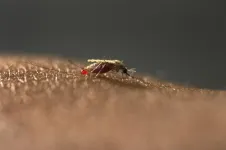(Press-News.org) Working to develop new treatments for osteoarthritis, researchers at Washington University School of Medicine in St. Louis have genetically engineered cartilage to deliver an anti-inflammatory drug in response to activity similar to the bending of a knee or other motions that put stress on joints.
Among the early symptoms of osteoarthritis is pain in response to such movements -- motions that involve the so-called mechanical loading of a joint. Joint pain that accompanies bending or lifting can make it difficult to perform normal activities. But by altering genes in cartilage cells in the laboratory, the researchers have been able to program them to respond to the mechanical stress associated with movement and weight-bearing by producing a drug to combat inflammation.
The study is published online Jan. 27 in the journal Science Advances.
"Drugs such as ibuprofen and naproxen that ease joint pain and lower systemic inflammation are the main treatments for osteoarthritis pain, but there are no therapies that actually prevent damage in the joints of patients with this debilitating form of arthritis," said senior investigator Farshid Guilak, PhD, the Mildred B. Simon Professor of Orthopaedic Surgery. "We've developed a new field of research called mechanogenetics, where we can engineer cartilage cells to respond to the mechanical loading of the joint. Every time cells are under that stress, they produce an anti-inflammatory, biologic drug to reduce inflammation and limit arthritis-related damage."
With his team, Guilak, a co-director of the Washington University Center of Regenerative Medicine and director of research at Shriners Hospitals for Children -- St. Louis, first conducted experiments in the lab using cartilage cells from pigs to figure out how those cells sense when they are being mechanically stressed.
"Studying these cells in the lab, we were able to identify key pathways in the cells that respond to stress from loading and the gene circuits in cartilage that are activated by mechanical loading," said co-first author Robert J. Nims, PhD, a postdoctoral researcher in Guilak's laboratory.
Like the touch sensor on a smartphone, cartilage cells sense when stress is being applied, and the inflammation associated with the excessive stress of arthritis causes cartilage to break down. The cells developed in these experiments, however, responded to that stress by secreting an anti-inflammatory drug that blocked cartilage damage.
"We altered snippets of DNA in the cells to tell them to do something different than normal when they sense a load," Guilak said. "That is, to make an arthritis-fighting drug."
"It's kind of like turning on a light," said co-first author Lara Pferdehirt, a biomedical engineer and graduate research assistant in Guilak's lab. "With a light, you flip a switch, and a light bulb turns on. But in this case, the switch is the mechanical loading of a joint, and the bulb is the anti-inflammatory drug."
The cells were engineered to release interleukin-1 receptor antagonist -- a drug called anakinra (Kineret) that's used to treat rheumatoid arthritis and shows promise for treating post-traumatic osteoarthritis that occurs following joint injury. Prior studies of the drug in patients with osteoarthritis have shown it to be safe but ineffective when only injected into a joint one time. Guilak believes that is because to work well, the drug must be released in arthritic joints over longer periods, while mechanical loading is occurring.
"This drug doesn't seem to work unless it's delivered continuously for years, which may be why it hasn't worked well in clinical trials involving patients with osteoarthritis," he said. "In our experiments in cells in the lab, we used existing signaling systems in the cartilage cells that we engineered so that they would release the drug whenever it's needed. Here, we are using synthetic biology to create an artificial cell type that we can program to respond to what we want it to respond to."
In addition to reducing inflammation in arthritic joints, having specific cartilage cells deliver the drug only when and where it's needed should make it possible to avoid side effects associated with long-term delivery of a strong anti-inflammatory drug to the entire body. Those side effects can include stomach pain, diarrhea, fatigue and hair loss.
Guilak's team plans to use the same technique to alter other types of cells to make different drugs.
"We can create cells that automatically produce pain-relieving drugs, anti-inflammatory drugs or growth factors to make cartilage regenerate," Guilak said. "We think this strategy could be a framework for doing what we might need to do to program cells to deliver therapies in response to a variety of medical problems."
INFORMATION:
Nims RJ, Pferdehirt L, Ho NB, Savadipour A, Lorentz J, Sohi S, Kassab J, Ross AK, O'Connor CJ, Liedke WB, Zhang B, McNulty AL, Guilak F. A synthetic mechanogenetic gene circuit for autonomous drug delivery in engineered tissues. Science Advances, Jan. 27, 2021.
This work was supported by Shriners Hospitals for Children and by the National Institute of Arthritis and Musculoskeletal and Skin Diseases and the National Institute on Aging of the National Institutes of Health (NIH). Grant numbers AR76665, AG46927, AG15768, AR74240, AR73752, AR074992, AG28716. Additional support from the Nancy Taylor Foundation, the Arthritis Foundation, the National Science Foundation (an NSF EAGER Award and NSF Graduate Research Fellowship Program -- DGE-1745038), The Phillip and Sima Needleman Fellowship, the Duke School of Medicine and a Duke Clinical and Translational Science Award.
Washington University School of Medicine's 1,500 faculty physicians also are the medical staff of Barnes-Jewish and St. Louis Children's hospitals. The School of Medicine is a leader in medical research, teaching and patient care, ranking among the top 10 medical schools in the nation by U.S. News & World Report. Through its affiliations with Barnes-Jewish and St. Louis Children's hospitals, the School of Medicine is linked to BJC HealthCare.
The blog "Ladyplanet. Natürlich Frau sein" is quite certain: "Our cycle is linked to that of the moon. The most obvious connection is the length of the two cycles," it says. The newspaper "Berliner Tagesspiegel" comes to the opposite conclusion: "The length of women's menstrual cycles is an average value, for some it lasts longer, for others it is shorter. Even one and the same woman can have cycles of different lengths. If they really were connected to the lunar cycle, all women would have their fertile days at the same time," the paper's knowledge section reads.
So what is true? A team led by Würzburg chronobiologist Charlotte Förster has now used scientific methods to examine the connection between ...
Organelles continue to thrive after the cells within which they exist die, a team of University of Bristol scientists have found, overturning previous assumptions that organelles decay too quickly to be fossilised.
As described in the journal Sciences Advances today [27 January], researchers from Bristol's School of Earth Sciences were able to document the decay process of eukaryotic algal cells, showing that nuclei, chloroplasts and pyrenoids (organelles found within chloroplasts) can persist for weeks and months after cell death in eukaryote cells, long enough to be preserved as fossils.
Emily Carlisle, a PhD student from Bristol's School of Earth Sciences and co-author, was able to characterise the transformation of the organelles into ...
An analysis of long-term menstrual cycle records kept by 22 women for up to 32 years shows that women with cycles lasting longer than 27 days intermittently synchronized with cycles that affect the intensity of moonlight and the moon's gravitational pull. This synchrony was lost as women aged and when they were exposed to artificial light at night. The researchers hypothesized that human reproductive behavior may have been synchronous with the moon during ancient times, but that this changed as modern lifestyles emerged and humans increasingly gained exposure to artificial light ...
Larvae of a new malaria mosquito species are abundantly present in water containers in cities in Ethiopia. The mosquito, Anopheles stephensi, is the main malaria mosquito in India but only appeared on the African continent a few years ago. It has now been found in cities and towns in urban settings in Ethiopia, Sudan, and Djibouti. Researchers from the Radboud university medical center and the Armauer Hansen Research Institute in Ethiopia showed that the invading mosquito species is highly susceptible to local malaria strains. Malaria can therefore become an increasing problem for urban areas in ...
Pioneering work led by a joint China-UK consortium has revealed the origin of one of the world's most important ecosystems, the East Asian biodiversity "hotspot," thus solving a longstanding riddle as to what prompted its formation and evolution.
In a recent study published in Science Advances, a joint research team led by scientists from Xishuangbanna Tropical Botanical Garden (XTBG) of the Chinese Academy of Sciences, the University of Bristol (UK) and the Open University (UK) has revealed the first direct mechanism explaining how the growth of mountains in Northern Tibet drastically altered climate, vegetation and plant diversity in East Asia.
The researchers used an innovative climate model that simulates ...
(Embargoed for January 28, 2021 3 a.m. SPT; January 27th 2 pm EST, 2021) -- Note: this study is scheduled for publication in the Journal Science Translational Medicine)
A study presented today by Dr. Nobuyuki Takahashi of the Center for Cancer Research (CCR), National Cancer Institute (NCI), Bethesda, Md. at the IASLC World Conference on Lung Cancer Singapore demonstrates that small cell lung cancer (SCLC) may have an inherited predisposition and lays the foundation for understanding the interaction between genotype and tobacco exposure in exacerbating SCLC risk as well as potential therapeutic implications. Because tobacco is the dominant carcinogen, secondary causes of lung cancer are often diminished in perceived importance, especially in SCLC, the most lethal ...
A study has revealed for the first time the ancient origins of one of the world's most important ecosystems by unlocking the mechanism which determined the evolution of its mountains and how they shaped the weather there as well as its flora and fauna.
It was previously thought Southern Tibet and the Himalaya were instrumental in turning the once barren land of eastern Asia into lush forests and abundant coastal regions which became home to a rich array of plant, animal and marine life, including some of the world's rarest species. But new findings, published today in the journal Science Advances, conversely show Northern Tibet played the more influential role in this transformation which began more than 50 million years ago.
Scientists from a UK-China partnership, ...
By Elton Alisson | Agência FAPESP - Melatonin synthesized in the lungs acts as a barrier against SARS-CoV-2, preventing expression of genes that encode proteins in cells such as resident macrophages in the nose and pulmonary alveoli, and epithelial cells lining the alveoli, all of which are entry points for the virus. The hormone, therefore, prevents infection of these cells by the virus and inhibits the immune response so that the virus remains in the respiratory tract for a few days, eventually leaving to find another host.
The discovery by researchers at the University ...
A study led by a University of Illinois Chicago researcher uses a new approach to measure precarious, or low-quality, employment in the United States. And, according to those findings, precarious employment has increased 9% between 1988 and 2016.
Precarious employment, or P.E., is defined as low-quality employment, which is often characterized by low wages, job insecurity and irregular hours, making employment risky and stressful for the worker.
In her study, "Changes in precarious employment in the United States: A longitudinal analysis," Vanessa Oddo, assistant professor in UIC's School of Applied Health Sciences, sought to create ...
People who are pregnant, breastfeeding or trying to conceive should be offered the severe acute respiratory syndrome coronavirus 2 (SARS-CoV-2) vaccine based on ethical grounds, argue authors of a commentary in CMAJ (Canadian Medical Association Journal).
They discuss how health care providers and patients can use a shared decision-making approach to weigh the risks and benefits to decide on the right action for the individual.
"Core principles of medical ethics hold that medical decisions or interventions should respect individuals' autonomy, be just, be beneficial (beneficence), and not cause harm (nonmaleficence)," writes Dr. Jonathan Zipursky, Sunnybrook Health Sciences Centre and the University ...



